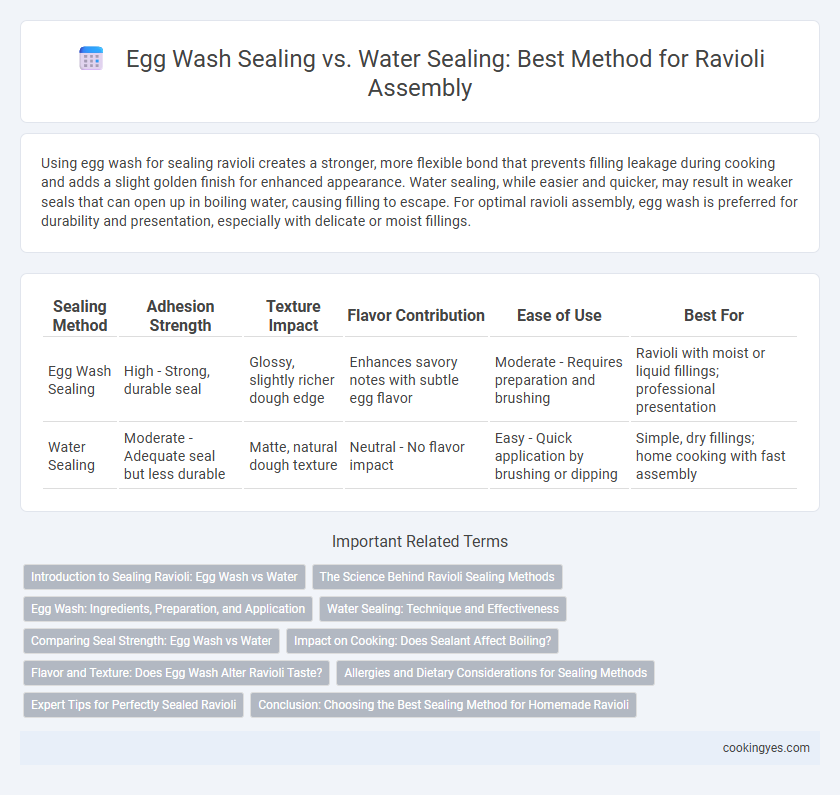Using egg wash for sealing ravioli creates a stronger, more flexible bond that prevents filling leakage during cooking and adds a slight golden finish for enhanced appearance. Water sealing, while easier and quicker, may result in weaker seals that can open up in boiling water, causing filling to escape. For optimal ravioli assembly, egg wash is preferred for durability and presentation, especially with delicate or moist fillings.
Table of Comparison
| Sealing Method | Adhesion Strength | Texture Impact | Flavor Contribution | Ease of Use | Best For |
|---|---|---|---|---|---|
| Egg Wash Sealing | High - Strong, durable seal | Glossy, slightly richer dough edge | Enhances savory notes with subtle egg flavor | Moderate - Requires preparation and brushing | Ravioli with moist or liquid fillings; professional presentation |
| Water Sealing | Moderate - Adequate seal but less durable | Matte, natural dough texture | Neutral - No flavor impact | Easy - Quick application by brushing or dipping | Simple, dry fillings; home cooking with fast assembly |
Introduction to Sealing Ravioli: Egg Wash vs Water
Egg wash and water serve as common sealing agents in ravioli assembly, each impacting dough adhesion and final texture differently. Egg wash, composed of beaten eggs, provides a stronger seal and promotes a golden, glossy finish after baking or frying, enhancing both appearance and structural integrity. Water, being a simpler option, moisturizes the dough edges for effective sticking but results in a less durable seal and a matte finish, making it preferable for softer, boiled ravioli.
The Science Behind Ravioli Sealing Methods
Egg wash sealing creates a protein-rich barrier that enhances adhesion between pasta layers by coagulating during cooking, resulting in a stronger, more durable seal for ravioli. Water sealing relies on simple moisture to bond the dough edges, which can be less effective as it lacks the cohesive protein matrix formed by egg wash. The differing chemical reactions during cooking influence the ravioli's texture and leak resistance, making egg wash the preferred method for preserving filling integrity and preventing rupture.
Egg Wash: Ingredients, Preparation, and Application
Egg wash for ravioli sealing typically consists of a mixture of beaten eggs and a small amount of water or milk to enhance adhesion. Preparation involves whisking the eggs until smooth, ensuring an even coat when applied with a brush along the pasta edges. Applying egg wash creates a strong, flexible seal that prevents filling leakage during cooking, resulting in perfectly formed ravioli with a golden, glossy finish.
Water Sealing: Technique and Effectiveness
Water sealing for ravioli assembly involves brushing the dough edges with water to create a moisture bond that helps the pasta sheets adhere securely without altering flavor or texture. This technique effectively prevents filling leakage during cooking by softening the dough edges, allowing them to fuse seamlessly when pressed together. Compared to egg wash, water sealing is a preferred method for maintaining a neutral taste and is especially suitable for vegan or allergy-sensitive recipes.
Comparing Seal Strength: Egg Wash vs Water
Egg wash sealing creates a stronger, more durable bond for ravioli edges compared to water sealing due to its sticky protein content that improves dough adhesion during cooking. Water sealing may result in weaker seams prone to opening or leakage, especially after boiling or frying, because it lacks the binding properties of egg wash. Professional pasta makers often prefer egg wash for consistently secure ravioli assembly that maintains shape and prevents filling loss.
Impact on Cooking: Does Sealant Affect Boiling?
Egg wash sealing creates a stronger, more durable bond on ravioli edges compared to water sealing, reducing the risk of pasta bursting during boiling. The protein and fat in an egg wash help form a tight seal that withstands the agitation and heat of boiling water, ensuring the filling remains intact. Water sealing provides a temporary adhesive but is more prone to loosening, which can result in leakage and a compromised texture after cooking.
Flavor and Texture: Does Egg Wash Alter Ravioli Taste?
Egg wash sealing enhances ravioli by adding a subtle richness and golden color, which slightly alters the flavor with a hint of egginess while creating a firmer, glossy texture that holds fillings securely. Water sealing, being neutral, preserves the pasta's original flavor and yields a softer, more delicate texture without influencing the taste. Choosing egg wash impacts the overall sensory experience, contributing a richer mouthfeel and visual appeal compared to the more traditional, flavor-neutral water seal.
Allergies and Dietary Considerations for Sealing Methods
Egg wash sealing enhances ravioli edges by creating a strong bond but poses allergy risks for individuals with egg sensitivities, requiring clear labeling to prevent allergic reactions. Water sealing offers a hypoallergenic alternative, suitable for egg-free or vegan diets, ensuring inclusivity without compromising the seal's integrity. Choosing the sealing method depends on catering to dietary restrictions and allergy concerns to ensure safe consumption.
Expert Tips for Perfectly Sealed Ravioli
Egg wash sealing ensures a stronger, more durable bond for ravioli edges, preventing filling leakage during boiling and producing a golden, appetizing crust when baked. Water sealing is simpler but may result in weaker seals prone to opening, especially with moist fillings like ricotta or spinach. Experts recommend using egg wash for robust seals in gourmet ravioli and reserving water sealing for quick, delicate pasta that will be immediately cooked.
Conclusion: Choosing the Best Sealing Method for Homemade Ravioli
Egg wash sealing offers a stronger and more durable bond for homemade ravioli, preventing leakage during cooking and enhancing browning for a more appealing texture. Water sealing is easier and quicker but may result in less secure edges, increasing the risk of filling spillage. For optimal results, especially with moist fillings, egg wash sealing is the preferred method to ensure sturdy, well-sealed ravioli with a polished finish.
Egg wash sealing vs Water sealing for ravioli assembly Infographic

 cookingyes.com
cookingyes.com